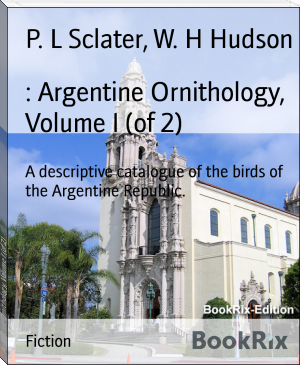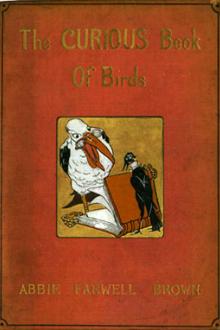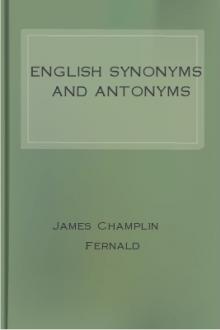: Argentine Ornithology, Volume I (of 2), P. L Sclater, W. H Hudson [best authors to read txt] 📗

- Author: P. L Sclater, W. H Hudson
Book online «: Argentine Ornithology, Volume I (of 2), P. L Sclater, W. H Hudson [best authors to read txt] 📗». Author P. L Sclater, W. H Hudson
plains, where it was once the dominant Finch, it has utterly vanished.
84. EMBERNAGRA OLIVASCENS (d'Orb. et Lafr.). (OLIVE GROUND-FINCH.)
+Embernagra olivascens+, _d'Orb. Voy., Ois._ p. 285; _Burm. La-Plata
Reise_, ii. p. 485 (Mendoza); _Scl. et Salv. Nomencl._ p. 32;
_Salvin, Ibis_, 1880, p. 355; _Döring, Exp. al Rio Negro, Zool._
40 (R. Colorado).
_Description._--Similar to _Embernagra platensis_, but the back
unstriped, and the olive hue somewhat purer; also the abdomen of a
paler buff: total length 8·1 inches, wing 3·7, tail 4·0. _Female_
similar.
_Hab._ Bolivia, Western Argentina, and Patagonia.
This species, which was met with by Dr. Burmeister near Mendoza, was
found by Dr. Döring as far south as the Rio Colorado, on the pampas.
85. EMBERIZOIDES SPHENURUS (Vieill.). (WEDGE-TAILED GROUND-FINCH.)
+Embernagra macroura+, _d'Orb. Voy., Ois._ p. 285. +Emberizoides
macrurus+, _Burm. La-Plata Reise_, ii. p. 485 (Paraná).
+Emberizoides sphenurus+, _Scl. et Salv. Nomencl._ p. 33.
_Description._--Above yellowish brown, striped with black; shoulders
edged with yellow; wing-feathers blackish, edged with olive-green;
tail-feathers blackish, edged with pale brown; beneath pale
ochraceous brown, white on the throat and middle of the belly;
bill and feet pale horn-colour: whole length 8·0 inches, wing 3·1,
tail 4·0.
_Hab._ Brazil, Bolivia, Paraguay, and Argentina.
Burmeister met with this species near Paraná and in other parts of
Northern Argentina.
86. HÆMOPHILA WHITII (Sharpe). (WHITE'S GROUND-FINCH.)
+Zonotrichia whitii+, _Sharpe, Cat. B._ xiii. p. 608, pl. xiii.
+Zonotrichia strigiceps+, _White, P. Z. S._ 1883, p. 38
(Cordova).
_Description._--Above, head and neck grey, variegated with dark
chestnut; back yellowish brown with black stripes; wings and tail
blackish, the feathers edged with pale brown; beneath, throat and
belly white, breast pale grey; sides yellowish brown; bill dark
horn-colour, lower mandible whitish; feet light horn-colour: whole
length 6·0 inches, wing 2·5, tail 2·8.
_Hab._ Northern Argentina.
This species has been based by Mr. Sharpe on a specimen, obtained
by White near Cordova, which was wrongly determined as _Zonotrichia
strigiceps_--a species that it somewhat resembles in its upper plumage.
87. CHRYSOMITRIS ICTERICA (Licht.). (BLACK-HEADED SISKIN.)
Chrysomitris barbata+, _Scl. et Salv. P. Z. S._ 1868, p. 140 (Buenos
Ayres); _Durnford, Ibis_, 1877, p. 172 (Buenos Ayres); _White, P.
S._ 1882, p. 600 (Catamarca, Misiones); _Döring, Exp. al RioNegro, Zool._ p. 40 (R. Sauce, R. Colorado, R. Negro); _Barrows,
Bull. Nutt. Orn. Cl._ viii. p. 132 (Concepcion). +Chrysomitris
magellanica+, _Burm. La-Plata Reise_, ii. p. 489; _Gibson, Ibis_,
1880, p. 30 (Buenos Ayres); _Salvin, Ibis_, 1880, p. 355 (Salta).
+Chrysomitris icterica+, _Sharpe, Cat. B._ xii. p. 217.
_Description._--Above light olive-green; lesser wing-coverts same as
the back; wings black, a broad bright yellow band across the base
of the feathers; rump yellow; upper tail-coverts olive-green;
tail-feathers yellow at the base and black at the ends; head all
round and throat velvety black; beneath and under wing-coverts
bright yellow: total length 5·0 inches, wing 3·0, tail 1·8. _Female_
without the black on the head, otherwise similar to the male, but
less bright.
_Hab._ Brazil and Argentina.
This beautiful little golden-plumaged Finch, the male distinguished from
his consort by a brighter yellow colour and a black head, is extremely
common throughout the entire length of the Argentine country from
Brazil to Patagonia. In the Buenos-Ayrean district it probably has a
partial migration, as small flocks are seen to arrive in spring; but
further south, in Patagonia, it appears to be strictly resident. In
settled districts they are always more abundant than in the woods, and
they have a special predilection for poplar groves, and always prefer a
poplar to build in. They go in small flocks, seldom more than about a
dozen birds together, have a rapid, undulating flight, feed chiefly
on the ground like most Finches, and also frequently alight in the
seeding-time on plants like the lettuce and _Sonchus asper_ (a common
weed) and, clinging to the stem, dexterously pick off the seed,
scattering the down about them in a little cloud. They are very tuneful,
restless, quick in their motions, apparently always in a light-hearted
merry mood. Being much admired for their song, they are often kept in
cages; and certainly, for cheerfulness and constancy in singing, they
take the foremost place amongst the Finches; but there is little
expression in the song, which is composed of a variety of short
twittering notes, uttered with great rapidity, as the bird sits perched
on a twig or undulates from tree to tree. Usually the notes flow in
a continuous stream, but occasionally the bird sings in a different
manner, making a pause of two or three seconds of silence after every
eight or ten short notes. When the female is on the nest the male
sometimes perches near her amongst the leaves and sings _sotto voce_,
apparently for her pleasure only, the notes being so low that, at a
distance of ten yards, they can scarcely be heard.
The nest is usually placed between the angle formed by a small branch
and the bole of the tree, and is a deep, well-made structure composed of
many materials, and lined with horsehair, down, or feathers. The eggs
are five, very small for the bird, pure white, and so frail that it is
not easy to take them from the nest without breaking them.
While engaged in building, the birds constantly utter a low, soft,
trilling note; and when the nest is approached they break out into long,
somewhat reedy notes, resembling those of the Canary, expressive of
alarm or curiosity.
88. CHRYSOMITRIS ATRATA (d'Orb. et Lafr.). (HALF-BLACK SISKIN.)
+Carduelis atratus+, _d'Orb. Voy., Ois._ p. 364, t. 48. fig. 2.
+Chrysomitris atrata+, _Burm. La-Plata Reise_, ii. p. 490
(Mendoza); _Sharpe, Cat. B._ xii. p. 212.
_Description._--Black; concealed shoulder-spot, broad band on wing,
basal half of tail-feathers, belly, and under tail-coverts bright
yellow; bill and feet horn-colour: whole length 5·4 inches, wing
2·9, tail 1·8.
_Hab._ Bolivia and N.W. Argentina.
Dr. Burmeister obtained two examples of this species in the Sierra of
Uspallata near Mendoza.
89. SYCALIS PELZELNI, Scl. (YELLOW HOUSE-SPARROW.)
+Sycalis pelzelni+, _Scl. Ibis_, 1872, p. 42; _Scl. et Salv.
Nomencl._ p. 34; _Durnford, Ibis_, 1877, p. 172 (Buenos Ayres).
_Description._--Above yellowish olive-green, the back sparsely
striped with blackish; wing- and tail-feathers black, edged with
yellow; forehead bright orange, the rest of the head like the back;
below bright yellow; under surfaces of wings and tail also yellow:
total length 5·4 inches, wing 2·7, tail 2·2. _Female_ dull brownish
grey mottled with blackish above; under surface whitish grey,
striped with dusky brown on the breast; wing- and tail-feathers
edged with yellow.
_Hab._ S. Brazil, Paraguay, and Argentina.
The Yellow "House-Sparrow," as this species is called, is the town-bird
of Buenos Ayres, but does not multiply greatly, nor is he familiar with
man, like his rough, sooty-plumaged, far-away London relation.
The forehead of the male is bright orange, the prevailing colour of the
entire plumage yellow, clouded with other hues. The female is grey,
marked with pale fuscous, and is less in size than her mate. They remain
with us all the year and live in pairs, the sexes in this species being
faithful. Sometimes they are seen associating in small flocks, but I am
inclined to believe that only the young unmated birds are gregarious. In
1867-8, during the cholera epidemic in Buenos Ayres, the Sparrows all
disappeared from the town, and I was told by the manager of a large
steam flour-mill in the town that the birds had not gone away, but had
died. They were found dead all about the mill where they had been very
abundant. My informant was a careful observer, and I have no doubt that
he was correct in what he told me.
In spring and summer the male sings frequently with great energy, but
without much melody. After a hurried prelude of sharp chirps and trills,
he pours out a continuous stream of sound, composed of innumerable brief
notes, high and shrill as those of a bat, wounding the ear with their
excessive sharpness, and emitted so





Comments (0)